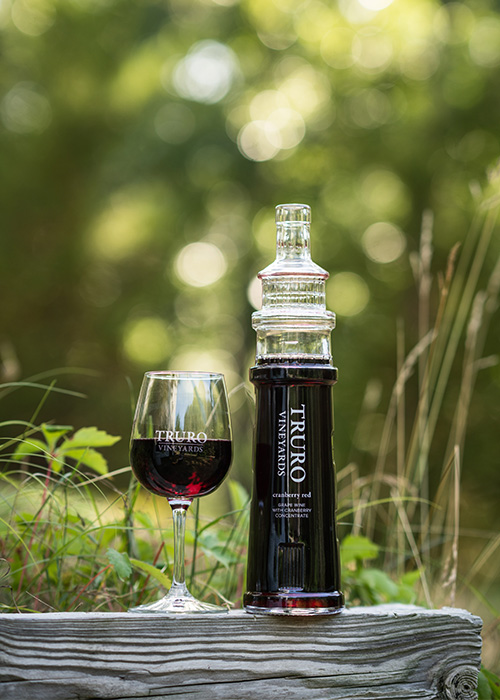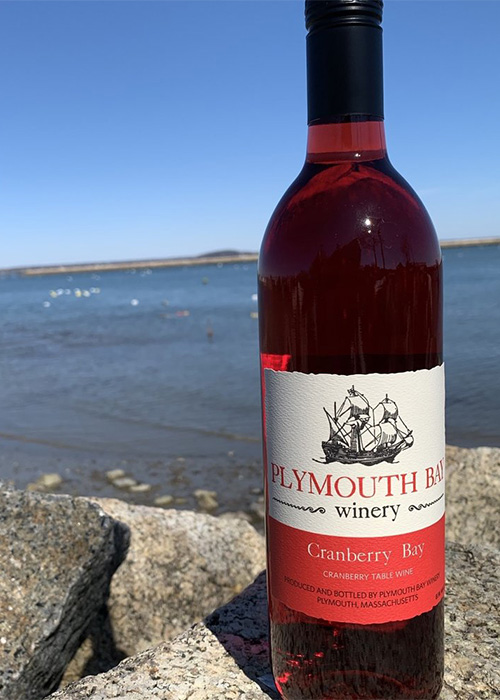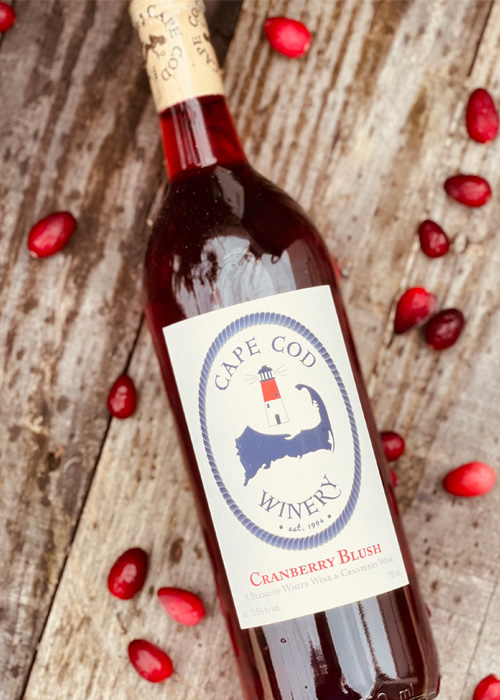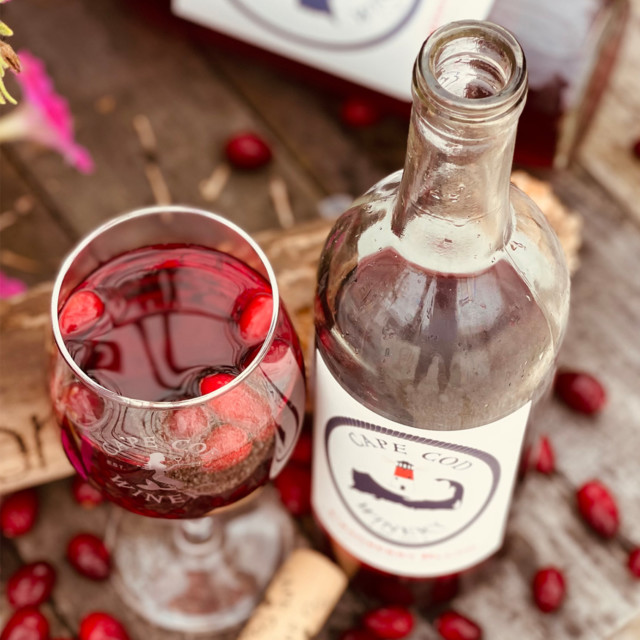Cranberries and cocktails have been acquainted for some time. There’s the Cape Codder, the summertime-and-the-living-is-easy cocktail that debuted in the 1940s, typically made with cranberry juice and vodka and lime. Fast forward to the 1990s, and “Sex and the City” put the Cosmopolitan cocktail on the map. Both are still enjoyed, although not as popular as they were in their heyday. But cranberry lovers haven’t soured on the idea of sipping cranberries. And while cranberry sauce and relish have their coveted place on Thanksgiving tables, wine lovers can also enjoy the acidic berry in cranberry wine.
Fruit wines are trending, especially in New England. It’s no surprise cranberry wine is having a moment: The secret to a good fruit wine is fresh fruit, and cranberries are as fresh as they come in New England, straight from the bog. In fact, the cranberry is the state’s official fruit. But, while cranberries have been harvested here for hundreds of years, just when cranberry wine first debuted is up for speculation.
“A good guess is that [cranberry wine] became more prominent during Prohibition when drinkers were often forced to fend for themselves in the absence of available alternatives,” says Charles Dodge, owner of Charles of Putney Mountain Winery and Spirits in Putney, Vt. “At this time of year, the fall, Simply Cranberry is our best-selling wine,” he says, noting that the cranberries that Putney uses are sourced from Cape Cod bogs.
New England put Thanksgiving on the table, and as one of the region’s star fruits, the cranberry was feted by the Pilgrims at their celebratory meal. It’s believed that even before the Mayflower landed in America in Provincetown, Mass., Native Americans valued the tart berry for its medicinal powers. And according to some health experts, cranberries have earned superpower fruit status in recent years, too, thanks to impressive antioxidant and anti-inflammatory properties.
Today, cranberry wine may still be made in some basements like during the Prohibition years, but it is also widely available in liquor stores, markets, and wineries across the country.
Truro Vineyards of Cape Cod
A vineyard, winery, and distillery spanning seven acres on the tip of Cape Cod, Truro Vineyards makes a Cranberry Red as part of the winery’s Lighthouse Series, which celebrates the Cape’s iconic lighthouses and regional tastes. The wine is packaged in a lighthouse-shaped bottle.
“Our cranberry wine is our most popular wine,” says co-owner Kristen Roberts. “It outsells everything else, especially at Thanksgiving. We sell about 2,000 cases a year.”
The organic cranberries are purchased from Carver, Mass.-based grower Decas Farms. Neighboring Plymouth, the family brand has 450 acres of its own bogs, and sources cranberries from 150-plus local bog growers in Massachusetts. They’ve been at it for 80 years.
Truro Vineyards’ Cranberry Red, Roberts says, “is not fermented cranberries but rather a grape wine (a 50/50 blend of Roujean and Syrah grapes) that we ferment in stainless steel and then add cranberry. So it has some sweetness for sure but is also tart because of the cranberries.”
And, the wine is not just a sidekick for turkey dinner. “We make our cranberry sauce with it every year and it’s delicious,” Roberts says. “It also really does make a great base for sangria.”

Plymouth Bay Winery
Sharing the same town with Plymouth Rock, a Thanksgiving symbol, this winery is a Plymouth rock star on Thanksgiving.
“We actually have two cranberry wines,” says Michael Carr, who owns the winery with his wife, Pamela. “Our Cranberry Blush and Cranberry Bay or, as we like to say, our ‘pucker’ and ‘kiss.’”
Cranberry Blush is described as a semi-dry blend of cranberry and Vidal grapes, and is a top seller in the summer months, while Cranberry Bay is a sweet-and-tart wine popular around Thanksgiving and the holidays, Carr says. The cranberries are sourced locally in southeast Massachusetts.
And the wines are not just for sipping. Carr says some guests marinate their turkey with the Cranberry Bay wine. Also, keeping with the lustful theme, the winery makes a jelly with the cranberry wine and crushed cranberries called Crangasm.

Cape Cod Winery
Cranberry Blush is the cranberry-forward grape wine made at Cape Cod Winery in East Falmouth, Mass. The wine is made with organic cranberries also sourced from Decas Farms. (While the cranberries are organic the Riesling is not, so the wine isn’t classified organic.)
“We make the cranberry wine and then blend it with our Riesling (the grapes come from central California) so the white wine really balances out the sweetness and tartness of the fruit,” says Erika Orlandella, who owns the winery with her husband Peter.
“We really see a spike in the cranberry wine sales during the holiday season,” Orlandella says. “However, it is popular year-round as many people will make a wine sangria with this wine during the summer and fall months.”
Stay tuned: A cranberry red wine or cranberry ice wine are possible in the future, she says.
As for Thanksgiving, Orlandella recommends serving the wine with the main meal. Or, “it’s also really nice paired with a charcuterie, especially with a nice Brie,” she says. “Also a great complement to a semi-sweet chocolate.”

First Crush Winery
This no-frills, mid-Cape winery hidden in an industrial park in Harwich, Mass., produces two cranberry wines.
Three Sip Cran is made with local dry-picked cranberries from neighboring Thacher Bog, owned by the well-known, longtime Cape cranberry grower family, and with raisins from California. The cranberries are delivered in 300-pound totes, says Frank Puzio, owner of First Crush.
“It is not sweet, but tart, as it should be,” Puzio says. “We love it on ice with a fresh lime.”
A second wine, Cran Blanc, is made with those same berries and raisins but with the addition of Sauvignon Blanc grapes from California. Puzio describes it as not sweet, but less tart than the Three Sip Cran.
LaBelle Winery
New Hampshire’s LaBelle Winery produces two cranberry wines: Traditional Cranberry and Cranberry Riesling.
The Cranberry Riesling, a 50/50 blend of the Traditional Cranberry and Riesling wines, was introduced about four years ago and is a fan favorite. “So far this year, before the rush, we have sold about 900 bottles,” Marie King, lead educator at LaBelle Winery, says: “By blending in our Riesling wine, we have made the cranberry note softer and the wine more food friendly. It pairs very well with turkey, ham, and pork roast and is a little more sophisticated on the palate.”
Cooking with the cranberry wine is “a big yes” for King. “You can use it for creating cranberry sauces, compotes, or relishes,” she says. “But you can also use it to give a little cranberry zing to your stuffing, use it for brining your turkey, or reduce it and use it for a dessert sauce.”
The winery also sells its Spiced Cranberry jam (made with the cranberry wine) and suggests it as an accompaniment to a cheese. “At my house, I like to start guests off with a cranberry cocktail or cranberry Mimosa to whet their appetite, then serve the Cranberry Riesling for dining,” King says.
King notes the cranberry wine at LaBelle is very approachable for novice wine drinkers, and wonderful for cocktail recipes. “Toward the front of the palate it has sweet fruit and toward the back of the palate, a big, refreshing tart note,” she says. “We use it for our Cranberry Cosmo, Winemaker’s Smash, and I personally love it for spritzers with fresh lime juice, lime seltzer, and ice.”
And of course, it’s a perfect pairing for Thanksgiving. “Turkey and cranberry,” King says, “go together like peanut butter and jelly.”
